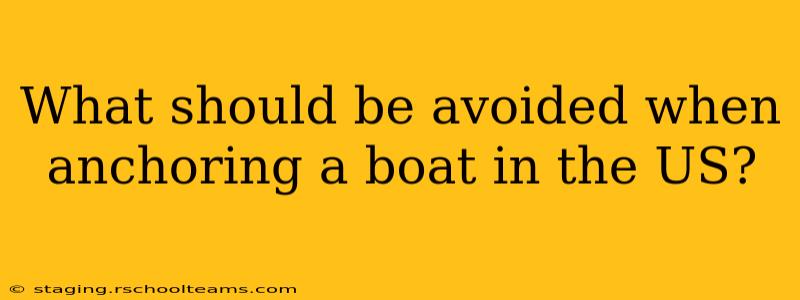Anchoring your boat in the US can be a relaxing and rewarding experience, but it's crucial to understand the regulations and potential hazards to ensure a safe and enjoyable time on the water. Ignoring these can lead to damage to your boat, hefty fines, and even potential harm to yourself and others. This guide outlines key areas to avoid when anchoring, categorized for clarity.
I. Navigationally Hazardous Areas
This is perhaps the most critical aspect of safe anchoring. Never anchor in areas that impede navigation or pose a threat to other vessels.
- Marked Channels and Fairways: These are clearly marked on nautical charts and designated for active vessel traffic. Anchoring here creates a significant obstruction and is strictly prohibited. Ignoring this can result in collisions and severe legal repercussions.
- Near Bridges and Tunnels: The proximity of bridges and tunnels usually necessitates specific clearance requirements. Dropping anchor too close can restrict vessel passage and is a serious safety violation. Always check local regulations and charts for clearance limits.
- Close to Buoys and Markers: Navigation aids like buoys and markers delineate safe waterways and hazards. Anchoring near or on top of these disrupts their function and can lead to accidents. Maintain a safe distance, as indicated on the charts.
- In Restricted Areas: Many areas are designated as restricted zones, often due to military operations, environmental protection, or other safety concerns. These restrictions are clearly marked, and anchoring within them is illegal. Consult your nautical charts and local regulations thoroughly.
II. Environmentally Sensitive Areas
Protecting our marine environments is paramount. Avoid anchoring in areas that could damage delicate ecosystems.
- Seagrass Beds: These underwater meadows are crucial habitats for marine life. Anchors can tear up these beds, causing significant long-term damage. Choose anchoring locations that avoid these vital ecosystems.
- Coral Reefs: Similar to seagrass beds, coral reefs are incredibly fragile and easily damaged by anchors. Anchoring on or near reefs can cause irreversible harm to these biodiversity hotspots. Many areas have designated mooring buoys to prevent this.
- Protected Marine Areas: Many areas are designated as Marine Protected Areas (MPAs) to conserve biodiversity and unique habitats. Anchoring restrictions often apply within MPAs; check the specific regulations for each area before anchoring.
- Spawning Grounds: Many species congregate in specific areas during spawning seasons. Anchoring in these areas disrupts the reproductive cycle, potentially affecting the population. Be aware of local spawning periods and avoid these sensitive locations.
III. Legally Restricted Areas
Besides navigational and environmental considerations, legal restrictions also govern anchoring.
- Private Property: Anchoring in a privately owned area without permission is illegal and can result in significant fines or legal action. Clearly marked private property should be avoided.
- Designated Swimming Areas: Anchoring in designated swimming areas obstructs recreational activities and poses a safety risk to swimmers. Choose alternate anchoring locations further away from these zones.
- Areas with Depth Restrictions: Make sure your anchor is appropriate for the water depth. Anchoring in areas shallower than your boat's draft can cause grounding.
IV. Practical Considerations for Safe Anchoring
Beyond specific locations, there are general considerations to ensure your safety and the safety of others:
- Check the Weather: Anchoring in inclement weather can be dangerous. Monitor weather forecasts before anchoring and be prepared to move your boat if conditions worsen.
- Use Appropriate Anchor and Rode: Ensure you have an anchor that is suitable for the type of bottom and the expected weather conditions. Adequate rode (anchor rope or chain) is also vital.
- Confirm Your Set: After dropping anchor, check its holding power by slowly pulling on the rode. A secure anchor will hold firmly.
- Leave Sufficient Swing Room: Account for tidal changes and wind shifts that will cause your boat to swing on its anchor.
By carefully considering these points, you can avoid problems and ensure a safe and enjoyable anchoring experience in US waters. Remember to always consult nautical charts, local regulations, and weather forecasts before dropping anchor. Enjoy responsible boating!
